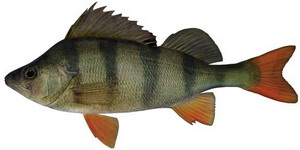

|

06 lbs |
03 oz |
00 drams |
02 kilos |
806 grams |
Year 2010 |
Distribution: Common in rivers lakes and ponds across Europe. Naturally found in England and introduced to Ireland, Scotland and Wales where it has now become widely established. A similar species - the yellow perch - is found in North America.
Features: A handsome deep bodied fish with bright red fins and bold vertical stripes on a dark green background. The fins have strong leading rays, which form a row of sharp spines along the dorsal fin. The gill covers are also armoured with sharp edges that can draw blood if handled without care. The perch has the large eye and wide gape of an active hunter.
Diet: The diet of most perch is made up of invertebrates. Small fish begin by feeding upon zooplankton, mainly cladocera, such as daphnia, before moving onto bloodworm and larger invertebrates as they grow. A small proportion of perch in each population begin feeding upon small fish when still very young. The fish that switch to a piscivorous diet grow much quicker than the others and are soon able to take larger fish in their diet. perch will take prey up to 60% of the width of their mouth, although they will attempt to feed upon much larger prey and can occasionally be caught on baits so large that they would not be able to swallow them.
Spawning: Perch spawn in May and April in shallow marginal areas where the water is calm. This means wind sheltered bays in lakes and the backwaters of rivers. The perch lay their eggs upon submerged plants and snags. Unlike other species of river fish, perch lay their eggs in clumps and strings that are often washed up after storms. The eggs are easy to hatch in clean water and it is very interesting to watch the young fish develop in their protective shells. The young fish hatch in about 8-12 days after which they begin feeding after about another week.
Growth: As mentioned above, perch are relatively slow growing fish that live for up to 12 years and reach sexual maturity at four years. These invertebrate feeders rarely weigh more than a pound in weight. Larger perch begin to grow quicker than their siblings from the age of about six months onwards. By the age of four these perch may be as much as two pounds in weight. In exceptional circumstances the perch will continue to grow rapidly for the whole of their lives.
The Perch can be found in most waters throughout the UK. A predator, the Perch hunts in packs often chasing small fish in the shallows, herding them towards other Perch until finally their prey are surrounded whereupon the pack embarks on a feeding frenzy. The Perch with it's colours and markings easily camouflages itself into it's surroundings, weed beds, sunken branches and tree roots. These colours and markings are less distinguishable in older specimens who tend to favour deep water and solitude, their colouring being darker and the markings indistinct. The Perch has two dorsal fins, the first dorsal fin being spined and having a conspicuous black spot to the rear.
Methods of Capture.
There are various ways of catching Perch. Float fished or legered worm or maggot will always tempt the fish especially if close to an obstacle or an overhanging tree . Spinning in shallow water or close to moored boats can equally tempt the Perch. The larger specimens are harder to find because of their solitary existence. A well place legered minnow or large worm can often tempt the older Perch. Some knowledge of the fishery can be helpful such as the location of sunken tree stumps and obstacles.
Tip: To attract perch into your swim just nip the bottom part of the worms tail of. This releases scent into the water to help perch find your hook bait.
©Norfolk Fishing Network 2004 - 2025®All Rights Reserved.